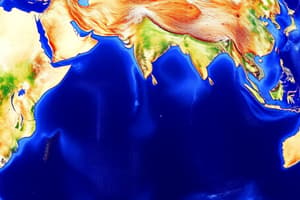Podcast
Questions and Answers
How did the Mappa Mundi exemplify the potential influence of cartographers' perspectives on mapmaking?
How did the Mappa Mundi exemplify the potential influence of cartographers' perspectives on mapmaking?
- By prioritizing mathematical precision over cultural representation.
- By accurately portraying all known geographic locations without bias.
- By excluding regions unknown to the cartographer, ensuring objectivity.
- By reflecting the mapmaker's understanding and preconceived ideas of physical and cultural geography. (correct)
In what way is Antarctica geographically distinct from all other continents?
In what way is Antarctica geographically distinct from all other continents?
- It is the only continent located entirely in the Western Hemisphere.
- It is the only continent that is also classified as a functional region.
- It is the only continent without a permanent human population. (correct)
- It is the only continent with regions clearly separated by a desert.
What characteristic defines 'functional regions,' as opposed to 'formal regions'?
What characteristic defines 'functional regions,' as opposed to 'formal regions'?
- Functional regions are based on physical geographic features, while formal regions are based on political boundaries.
- Functional regions rely on shared cultural or physical traits, while formal regions are defined by a shared system or dependency.
- Functional regions pertain only to administrative divisions, whereas formal regions are based on cultural characteristics.
- Functional regions are organized around a central hub with interdependent connections, while formal regions are based on common attributes. (correct)
If a geographer is studying regions separated by the Saharan Desert, which continent are they most likely studying?
If a geographer is studying regions separated by the Saharan Desert, which continent are they most likely studying?
What geographical feature serves as a subtle boundary between Europe and Asia within the supercontinent of Eurasia?
What geographical feature serves as a subtle boundary between Europe and Asia within the supercontinent of Eurasia?
Flashcards
Cartographers
Cartographers
Individuals who create maps dividing territories into geographic regions.
Types of Regions
Types of Regions
Administrative, formal, functional and vernacular.
Seven Continents
Seven Continents
North America, South America, Eurasia, Africa, Australia, Oceania, and Antarctica.
North and South America
North and South America
Signup and view all the flashcards
Antarctica
Antarctica
Signup and view all the flashcards
Study Notes
- Cartographers divide territories into geographic regions when creating maps.
- The Mappa Mundi shows how the mapmakers' ideas influenced their world documentation.
- Modern geographers divide territories into administrative, formal, functional, and vernacular regions.
Seven Main Worldwide Regions
- North America
- South America
- Eurasia
- Africa
- Australia
- Oceania
- Antarctica
- Eurasia combines Europe and Asia, divided by Eastern Europe and Western Asia.
- North and South America are in the Western Hemisphere, separated by the Isthmus of Panama.
- The remaining continents are in the Eastern Hemisphere.
- Antarctica is the only continent without permanent human civilizations.
- Africa's regions are mostly separated by the Saharan Desert, and the continent has great geographic diversity.
- Understanding world regions is more beneficial than the challenges it presents.
Studying That Suits You
Use AI to generate personalized quizzes and flashcards to suit your learning preferences.




